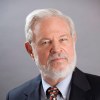Midwestern Voters Aren't Ready for Revolution

Where once there was one Midwest, rising and falling with the industrial era, there are now two Midwests, marching to different economic drummers.
Two Midwests
Without anyone much noticing, the old Midwest has gone away, and a new Midwest is taking its place. This is changing the way we live and the way we vote. The depth of this change is on display in the Democratic primaries, including the Illinois primary March 17, and may determine the outcome of the presidential election in November.
The old Midwest was the nation’s foundry and breadbasket, the throbbing citadels of industrial might and a thriving agricultural economy. In time, this gave way to the Rust Bowl, a battered landscape of hollowed factory cities and impoverished farm towns.
Now that’s changing. Where once there was one Midwest, rising and falling with the industrial era, there are now two Midwests, marching to different economic drummers. All this is chronicled in A Vital Midwest, a report by the Chicago Council on Global Affairs.
The ruined industrial landscape and dying rural areas remain, of course, and may never recover. But in their wake has risen a new Midwest that looks nothing like the silos and smokestacks of before.
This new Midwest is based on post-industrial industries – business services, health and medical, clean energy, IT, bioscience. Its new capitals are not the industrial behemoths such as Cleveland and Detroit and Youngstown, but places like Columbus, Indianapolis, Minneapolis, Ann Arbor and Des Moines. Many are state capitals or university towns or both. Few have a legacy of heavy industry to overcome. Most important, they are not the places that globalization left behind, but are plugged into the global economy and are thriving in it.
In short, the Midwest is caught in the painful shift from one economy to another, and its divided fortunes show this. It is a split between winners and losers, between well-educated city dwellers and the left behind, angry denizens of the old economy.
All this has big impacts that are economic and social – and political.
Four years ago, anger ruled Midwestern voting. Both Bernie Sanders and Donald Trump spoke to this resentment. Sanders nearly derailed Hillary Clinton’s nomination by promising a new deal for Midwestern voters, especially in Michigan. Trump won the presidency on the strength of Midwestern fury, especially in states such as Michigan and Ohio and Wisconsin, and a feeling that nobody in power was listening to them.
Both were revolutionaries preaching a reordering of society.
So far, this year’s primaries have taught us that Midwesterners aren’t ready for revolution. A Michigan that provided Sanders with his finest hour in 2016 turned on him this year and gave its votes to Joe Biden, a much more centrist candidate.
There are many reasons for Biden’s success so far. As a Pennsylvania native, he has Rust Belt roots and can speak to its pain. But he also is an establishment figure able to plug into the needs of the new Midwest and the educated, well-paid people who live there, both in its burgeoning cities and its suburbs.
That ability will be tested in the March 17 primaries, especially in Illinois and Ohio. Both have their thriving metropolises, such as Chicago and Columbus, and both have their Rush Belt refugees such as Dayton and Galesburg and Danville.
Right now, Biden has the momentum. The betting is that there are more votes in the new Midwest than the old one. If so, it will probably doom the Sanders movement.
Trump and the Republicans need to pay attention. Trump and Sanders speak to the same constituency and, four years ago, this constituency responded. But if Biden sweeps Illinois and Ohio, just as he swept Michigan, it may be a signal that the Midwest that elected Trump in 2016 may be ready to turn on him in 2020.

